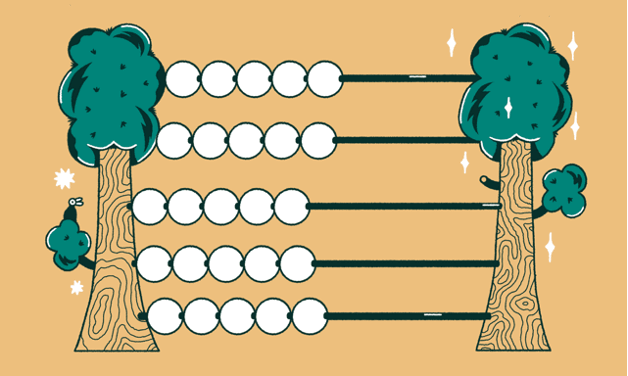Biomass: the pariah of the climate debate (NRC)
Few potential climate solutions are as controversial as burning biomass. Even nuclear energy has a better name these days. What makes biomass controversial?
By Paul Luttikhuis

The earth works like a cycle, everything returns at some point. Even fossil fuels such as coal, oil and gas. But that takes millions of years. Humanity cannot wait for that in its insatiable need for energy. This is different for wood. For every tree you cut down, you can plant a new one. And although wood emits 16 percent more CO2 per unit of energy produced than coal and even 94 percent more than gas, wood burns well. So renewable1https://www.nrel.gov/research/re-biomass.html.
That is why it is such an attractive idea to use biomass, such as wood, in power plants. So attractive, in fact, that biomass plays an important role in the sustainable energy mix of the European Union. According to the European Environment Agency2https://www.eea.europa.eu/en/analysis/indicators/share-of-energy-consumption-from, of all energy that the EU calls sustainable, 41 percent came from solid biomass last year, about the same as in the Netherlands, according to CBS figures3https://www.cbs.nl/nl-nl/nieuws/2023/22/aandeel-hernieuwbare-energie-in-2022-toegenomen-naar-15-procent.
The EU even offers billions in subsidies for this. A strict certification system must ensure that the money goes to the right place and does not contribute to, for example, illegal logging and the disappearance of biodiversity in natural forests. There are few energy sources where proponents and opponents are so diametrically opposed to each other. Even nuclear energy is less controversial these days. At the almost recent climate summit in Dubai, there were positive voices about nuclear energy, but it was noticeably silent about biomass, apart from a few ‘side events’4https://www.facebook.com/events/s/livestream-cop28-side-event-a-/723187163201796/ and an urgent letter to European Commissioner Wopke Hoekstra5https://comiteschonelucht.nl/boodschap-aan-wopke-hoekstra-voor-cop28-uitsluiten-verbranding-houtige-biomassa-van-mondiale-doelstelling-re/, the EU’s chief negotiator in Dubai. The letter warns against “over-reliance on biomass energy, at the expense of forests, biodiversity and essential carbon storage.”
Supporters don’t understand it
Why the fear? Supporters don’t understand it. The calculation is clear. “Biomass first removes CO2 from the air via photosynthesis, and that CO2 is released again when burned,” Martin Junginger explains in an email. He is professor of Biobased Economy at Utrecht University and an advocate of energy from biomass. “If you also ensure that the biomass, the tree, is replanted, no net carbon is added to the atmosphere. This is the case with fossil fuels.”
This is a reality on paper, says Louise Vet, former director of the Netherlands Institute of Ecology and emeritus professor of evolutionary ecology at Wageningen University & Research. She has been fulminating against the use of energy from biomass for years. According to her, the idea that for every felled tree a new one is planted that removes the released CO2 from the air ignores a fundamental problem: the “loss of time”. Scientists at MIT, the technological university in Massachusetts6https://thebulletin.org/premium/2022-05/does-wood-bioenergy-help-or-harm-the-climate/, have calculated that it takes 44 to 104 years for new plantings to absorb all the CO2 released from the atmosphere during combustion. And that doesn’t even take into account the extra CO2 that the now burned tree would have absorbed if it had not been cut down.
Junginger does not deny a ‘waste of time’. But according to him, it doesn’t have to be that complicated. How does he solve the problem of a tree that takes thirty years to store its carbon and is burned all at once? “In this example you cut down one tree, and then wait thirty years,” Junginger writes. “But a biomass power plant needs a continuous supply. And so you usually have thirty trees in the landscape – or better: thirty plots of forest – of which you harvest one plot every year. You let the 29 other plots grow quietly. They capture CO2 and thus compensate for the emissions from the combustion of that one plot.”
Moreover, advocates say, trees eventually die and release the stored carbon into the atmosphere as CO2. The same applies to pruning waste. If you leave it, it will rot and release CO2. Then you might as well stoke it.
Own rules of the game
But according to the opponents, nature has its own rules. “When burned, all CO2 immediately goes into the air,” says Louise Vet. “Wood that decays only emits a quarter to a third of its CO2 in ten years.” And a large part of the carbon in natural forests is absorbed by the soil. “That is an important source of nutrients and indispensable for the growth of the forest and therefore the capture of new CO2. Forests do not produce waste. Forests are the textbook example of a circular economy.” So it is better not to intervene, is the conclusion.
Junginger questions this. It is true, he says, that rotting is indeed not as rapid as combustion. But in the Netherlands, a thick branch is already 45 percent rotten after five years, while thinner branches are half rotten after less than two years. According to Junginger, other frequently heard criticism of the use of biomass is also unfounded: the fear of particulate matter. “That is a problem with fireplaces and wood stoves. Open fireplaces in particular are a significant source of particulate matter in the Netherlands. As far as I’m concerned, they should be banned immediately. Large-scale biomass power plants have extremely efficient filters, which means emissions are minimal. The biomass power plant in Utrecht, where I live, supplies 40 percent of the district heat. But the contribution to the total particulate matter load in the area is less than 0.1 percent. To reduce particulate matter emissions, it is better to drive 80 km on the A2 than to stop burning biomass in a power plant.”
According to Fenna Swart, director of the Clean Air Committee, the problem with burning wood is mainly ultrafine dust, the smallest particles. These are very harmful to people, animals and nature. “There are no filters for this in the Netherlands, nor have binding agreements been made about them,” says Swart. “The ministry has been working on a clean air standard for years, in line with EU standards. But this one is still on the drawing board.”
Junginger thinks that biofuels will remain necessary in the coming decades. Especially in economic sectors that are difficult to electrify – such as high-temperature heat in industry, and biofuels in aviation and shipping.
Junginger also considers sun and wind as a better and, above all, cheaper alternative for ‘normal’ electricity generation. But during what the Germans so beautifully call a Dunkelflaute, when the sun doesn’t shine and the wind doesn’t blow, a biomass power plant offers a necessary and, in Junginger’s eyes, sustainable backup. As long as it is necessary, it is really better to continue using gas, Swart believes. This will serve biodiversity and climate better. And the wind is actually always blowing at sea.
Source: https://www.nrc.nl/nieuws/2023/12/11/biomassa-de-paria-van-het-klimaatdebat-a4183920
- 1
- 2
- 3
- 4
- 5
- 6
